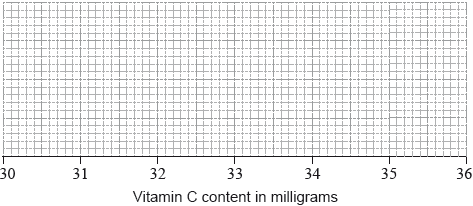| Date | May 2022 | Marks available | 2 | Reference code | 22M.2.SL.TZ1.3 |
| Level | Standard Level | Paper | Paper 2 | Time zone | Time zone 1 |
| Command term | Find | Question number | 3 | Adapted from | N/A |
Question
The scores of the eight highest scoring countries in the Eurovision song contest are shown in the following table.
For this data, find
Chester is investigating the relationship between the highest-scoring countries’ Eurovision score and their population size to determine whether population size can reasonably be used to predict a country’s score.
The populations of the countries, to the nearest million, are shown in the table.
Chester finds that, for this data, the Pearson’s product moment correlation coefficient is .
Chester then decides to find the Spearman’s rank correlation coefficient for this data, and creates a table of ranks.
Write down the value of:
the upper quartile.
the interquartile range.
Determine if the Netherlands’ score is an outlier for this data. Justify your answer.
State whether it would be appropriate for Chester to use the equation of a regression line for on to predict a country’s Eurovision score. Justify your answer.
.
.
.
Find the value of the Spearman’s rank correlation coefficient .
Interpret the value obtained for .
When calculating the ranks, Chester incorrectly read the Netherlands’ score as . Explain why the value of the Spearman’s rank correlation does not change despite this error.
Markscheme
(M1)
Note: This (M1) can also be awarded for either a correct or a correct in part (a)(ii).
A1
[2 marks]
their part (a)(i) – their (clearly stated) (M1)
IQR A1
[2 marks]
((IQR) ) (M1)
since R1
Netherlands is not an outlier A1
Note: The R1 is dependent on the (M1). Do not award R0A1.
[3 marks]
not appropriate (“no” is sufficient) A1
as is too close to zero / too weak a correlation R1
[2 marks]
A1
[1 mark]
A1
[1 mark]
A1
[1 mark]
A2
[2 marks]
EITHER
there is a (positive) association between the population size and the score A1
OR
there is a (positive) linear correlation between the ranks of the population size and the ranks of the scores (when compared with the PMCC of ). A1
[1 mark]
lowering the top score by does not change its rank so is unchanged R1
Note: Accept “this would not alter the rank” or “Netherlands still top rank” or similar. Condone any statement that clearly implies the ranks have not changed, for example: “The Netherlands still has the highest score.”
[1 mark]
Examiners report
In part (a), many candidates could use their GDC to find the upper quartile, but many forgot how to find the inter-quartile range.
In part (b), very few candidates knew how to show if a score is an outlier. Many candidates did not know that there is a mathematical definition to “outlier” and simply wrote sentences explaining why or why not a value was an outlier.
In part (c), candidates were able to assess the validity of a regression line. The justifications for their conclusion revealed a partial or imprecise understanding of the topic. Examples of this include “no correlation”, “weak value of ”, “low relationship”, “not close to 1”.
In part (d), about half of the candidates managed to find the correct values missing from the table.
In part (e), many candidates knew how to use their GDC to find Spearman’s rank correlation coefficient. Some mistakenly wrote down the value for instead of . Very few candidates could correctly interpret the value for as they became confused by the fact that linear correlation must go with the rank, otherwise it is about association. They could either have said “there is an association between population size and score” or “there is a linear correlation between the rank order of the population size and the ranks of the scores”.
In part (f), most candidates were able to work out that, even if the score changed, the rank remained the same.



